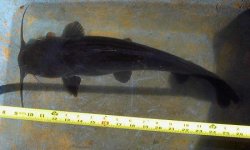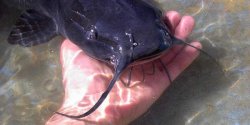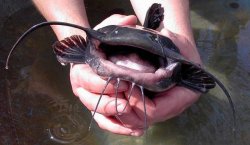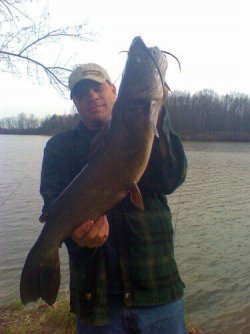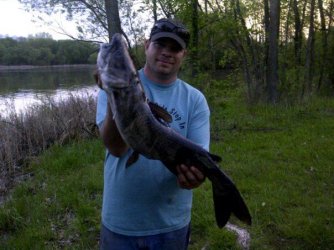Common name: Channel catfish, Spotted bluecat
Scientific name: Ictalurus punctatus
Family: Ictaluridae
Origin: Ohio, found in most large lakes and streams, all Great Lakes except Superior and also grown on fish farms.
Maximum size: 28"
Care: The channel catfish is a peacful community cat that can grow very big if put in a large pond. They will get along with just about every other fish and they will not bother smaller fish. They are bottom and middle water swimmers, however they will come up to the surface during feeding times and, when big, they are like vacuums eating food..
- Minimum Tank size would be at least 6 X 2 X 2 if you want them to grow big however I would only recommend putting them in ponds of at least 1000 gallons and with a minimum size of 10' X 4'X 3'
- Not sure how they handle water conditions in a tank as I have only had them in a pond
- They like rocks and hiding spots and long runs to swim in
Feeding: Channel catfish will eat any kind of Koi floating pellets. These are good to feed them if you want them to come to the top. They will also feed on submersible plants and algae especially string algae
Breeding: again not sure because I had three of them and they have never bred and a buddy of mine had two which also never bred. In the wild they breed in mostly rivers and streams in spring with warmer temps. The male guard the fry.
Sexing: Check the bottom of them. Males also become very dark during spawning season and develop a thickened pad on their head
Comments: They are really fun fish to have and they can clean up the bottom of a pond really well. If you can catch them be careful of their hook-like feelers on the sides of there mouth. Another point to put in there would be they can handle cold water (freezing over the top cold) as long as a hole is left open for the gases to escape. Also during the spring they tend to turn white somewhat but the color goes back after about a month.
Scientific name: Ictalurus punctatus
Family: Ictaluridae
Origin: Ohio, found in most large lakes and streams, all Great Lakes except Superior and also grown on fish farms.
Maximum size: 28"
Care: The channel catfish is a peacful community cat that can grow very big if put in a large pond. They will get along with just about every other fish and they will not bother smaller fish. They are bottom and middle water swimmers, however they will come up to the surface during feeding times and, when big, they are like vacuums eating food..
- Minimum Tank size would be at least 6 X 2 X 2 if you want them to grow big however I would only recommend putting them in ponds of at least 1000 gallons and with a minimum size of 10' X 4'X 3'
- Not sure how they handle water conditions in a tank as I have only had them in a pond
- They like rocks and hiding spots and long runs to swim in
Feeding: Channel catfish will eat any kind of Koi floating pellets. These are good to feed them if you want them to come to the top. They will also feed on submersible plants and algae especially string algae
Breeding: again not sure because I had three of them and they have never bred and a buddy of mine had two which also never bred. In the wild they breed in mostly rivers and streams in spring with warmer temps. The male guard the fry.
Sexing: Check the bottom of them. Males also become very dark during spawning season and develop a thickened pad on their head
Comments: They are really fun fish to have and they can clean up the bottom of a pond really well. If you can catch them be careful of their hook-like feelers on the sides of there mouth. Another point to put in there would be they can handle cold water (freezing over the top cold) as long as a hole is left open for the gases to escape. Also during the spring they tend to turn white somewhat but the color goes back after about a month.


